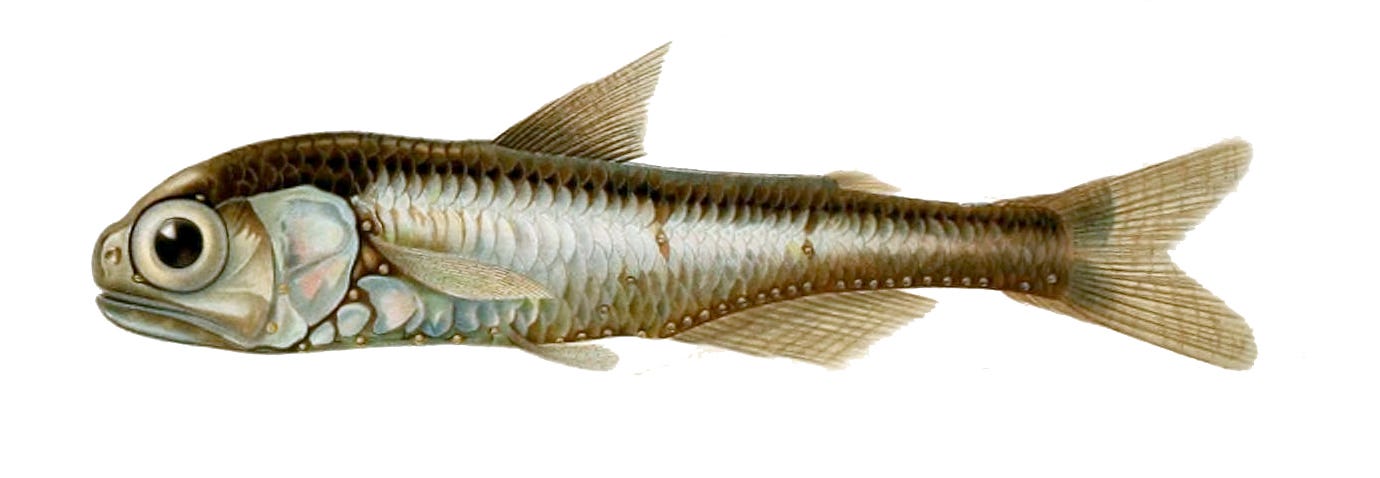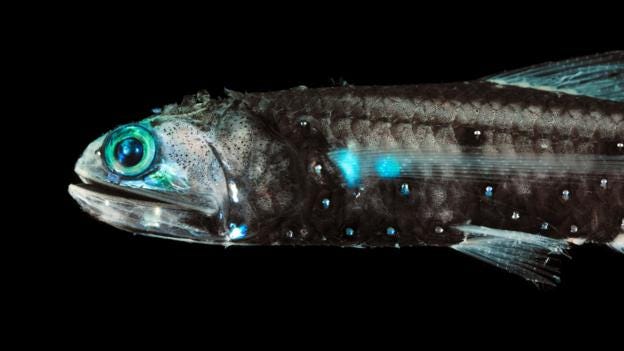
Naturally, if something like an anglerfish has a bioluminescent lure, there must be some form of prey that can succumb to this strategy. Nothing fits this role better than the lanternfish. This is a family of deep-sea fish that contains 246 different species. They are generally smaller, up to 30cm long with most being less than half that and they are everywhere. In fact, they are one of the most widespread vertebrate groups on the planet.
Deep sea trawl samples indicate that lanternfish make up 65% of the fish biomass of the deep ocean, between 550 and 660 million metric tons worldwide. This makes them a vital prey species for fish, marine mammals, and even penguins. All but one of the species exhibits bioluminescence, usually exhibited as rows of glowing dots along the ventral (or bottom) side of its head and body.

Unlike our previous bioluminescent organisms, these lights are not a lure or a warning. Instead, their most likely purpose of for interspecies identification. Each species of lanternfish has its own pattern of luminescence. Furthermore, many species also have a slight variance in the location of the light production between male and female fish. This allows for their bioluminescence to aid in shoaling behavior (staying together in a group) as well as courtship and mating.
The fact that lanternfish are so numerous also contributed to an early oceanographic mystery. As sonar began to be developed, strange readings occurred indicating some form of false sea floor. As it turns out, the sonar pulses were interacting with large groups of marine organisms and reflected back up. In fact, the sound waves were being reflected by the swim bladders of the deep sea fish. The swim bladder is an organ that allows for a fish to maintain its buoyancy, but it can also produce and receive sound. The sonar bounced off of the collection of fish in the ocean showing a false floor. This even seemed to rise and fall at night. This is because some species of lanternfish, especially the females, undergo a daily vertical migration in the water column, rising as night falls and returning to the deeps before dawn.
Lanternfish can be found in abundance in all of the world’s oceans and their bioluminescence illustrates an interesting dual purpose. It can be used for signalling and communication, but it also allows for a more defensive application: camouflage. Many marine organisms exhibit countershading: being darker on top and lighter on bottom to blend in with the background while being observed from both above and below. Lanternfish can take this adaptation a step further. The pattern of glowing lights on a fish’s underbelly can mimic the light level coming from the surface. This can mask its silhouette even more thoroughly than just a basic color contrast.
As with so many things, the use of bioluminescence in deep sea fish exhibits a bit of an ‘evolutionary arms race’. Each species developing new forms of offense and defense to overcome its competition. Light production has an added influence in such a setting because many other strategies are not possible in such an environment.
I’ll continue to switch between terrestrial and marine environments for the rest of Season 8. There’s still so much more to explore, so I hope to see you all for the rest of the journey. As always, please share this with others you think might enjoy these stories. Let me know what aspects of my writing you enjoy and where you think I can still improve.